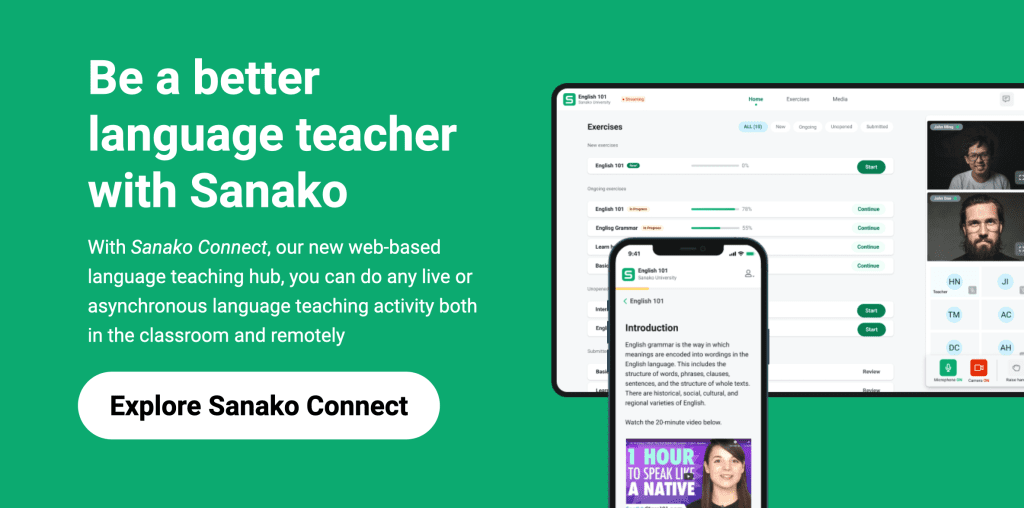In a previous blog post, we argued that learners of all major global languages (e.g Arabic, Chinese, English, French and Spanish) should be aiming for a level of competence known as international intelligibility. This is the capacity to make yourself understood in your target language (L2) when communicating with people from different first language (L1) backgrounds.
Perhaps the best example of this approach are language educators, many of whom are teaching languages which they do not speak natively. Taking English language as an example, given that there are now more non-native English speakers globally than native speakers, it’s highly likely that some English language learners will be taught be non-native speakers.
But does it actually make any difference whether students learn from a native-language speaker or a non-native speaker? Native speakers, in theory, should know their language intimately, faultlessly and naturally (Gill and Rebrova, 2001). Whereas non-native speakers are personally familiar with the students’ language learning process and therefore have a better understanding of the learners’ needs (Liu, 1999).
It’s a topic that sparks much debate across online language learning / teaching communities – so let’s get straight into it!
Spoiler alert – the answer, of course, is NO!
Quick definitions
Just to ensure that we’re starting on the same page, let’s start with a quick definition of a native and non-native speaker.
A native speaker or L1 user of a language is defined as a person who has spoken / used the language from earliest childhood. As Cook (1999) identifies this means that being a native speaker of a language is a biodevelopmental fact which cannot be changed afterwards in life through training or learning.
Non-native speakers of a language are those who have learned it as a L2 or L3, but who have a different language as their mother tongue. An L2 / L3 can never become someone’s native language.
Such definitions (and this broader argument) are important for two main reasons. Firstly, many language teaching job advertisements still specify that applicants must be native speakers. And secondly, many language students (as a consequence of point 1) express a preference for native-speaking teachers. So let’s look at the evidence and see if they are actually better teachers?
Advantages of native-speaking language teachers
Obviously, the main benefit of a native-speaking language teacher is that they speak more fluently and intuitively than their non-native colleagues. Beyond fluency, their use of language is typically more natural and derived from their life experience. As explained by Gill and Reborva (2001), the native language teacher’s language is also usually more correct and up to date. This is particularly important in helping students understand current and non-standard (e.g slang) language forms. For Medgyes (1999) the native speaker’s pronunciation, vocabulary and intonation as clear advantage for learners, describing them as the “perfect language model.”
In addition, native speakers can powerfully help students understand more than just the language – they’re perfectly placed to support students to learn about the culture behind it. If you’re learning Catalan, then there’s no-one better to tell you about the area, the history and the food, than a local. This provides a rich and engaging, real-life experience for learners.
Disadvantages of native-speaking teachers
However, there are undoubtedly some challenges with only specifying native-speaking teachers. Most importantly, they are often hired on the strength of their native speaker ability rather than their teaching skills. Just being able to speak / use the language is clearly not enough to be a successful teacher.
Native speakers may also struggle with teaching key grammar concepts. They’re able to get by on the strength of their ears and eyes – identifying what looks and sounds right but without being able to explain why. Non-native teachers have had to really learn the language from the ground up and are therefore better able to demonstrate and explain correct language use to L2 learners. Of course non-native speakers also understand the process of learning the language – this is unknown to the native teacher as she acquired the language as a child.
Allied to the above, Gill and Rebrova’s 2001 research identified that native speakers without an L2 in the country they are teaching in also encounter challenges. They’re not able to use the students’ L1 to explain concepts or problems nor can they identify where problems occur through negative transfer from the students’ native language.
Advantages of non-native speaking teachers
Perhaps most importantly, non-native speaking teachers are a clear example and motivator for their students. It’s encouraging for a student who is struggling to learn a new language to be taught by someone who has been there and done it. Non-native speakers are also brilliantly able to model and share the skills / strategies they used to find success.
Research also suggests that the teaching style typically deployed by non-native teachers may also be more effective than their native-speaking colleagues. They deliberately seek to integrate language into situational contexts to provide real-life relevance for students, whilst native speakers tend to teach using “more abstract” principles.
As outlined above, and of particular importance to lower ability students, teachers that share a mother tongue with the student are well-placed to teach effectively. They are able to use their common language to explain / translate difficult concepts or more easily teach key vocabulary. Knowledge of the students’ background also helps non-native speakers to better understand prevalent local teaching / learning styles / techniques as well as national policy and qualification frameworks.
Disadvantages of non-native speaking teachers
Evidently non-native speakers do not have the fluency, general language proficiency and cultural knowledge as their native speaker peers. As outlined above, this may be particularly noticeable in certain subject areas (e.g topical news and culture), the latest language usage and regional dialects.
Braine (1999) goes further suggesting that non-native speakers might also lack vital communicative competence. This is because they tend to only use the taught language in the classroom and might therefore lack regular non-teaching engagement with the language and native speakers. Their use of language could be outdated and too formal for everyday use.
Like us all, non-native teachers are the product of their upbringing and own environment. This can create challenges when teaching in different cultures. For example, much of the communication in a low context culture (like the US) is concise, explicit and clear and the key is to focus on the literal meaning of the world used. A teacher moving to India (a high context culture) would need to adapt quickly. Communication here requires reading between the lines – lots of meaning is implied and is communicated through non-verbal cues like hand gestures.
The conclusion to this blog post is, of course, that native and non-native speaking teachers have strengths and weaknesses like all other teachers and all other human beings. But for most language learners, both / either native and non-native speaking teachers can be highly effective in the classroom.
As a recent blog post by the British Council suggests, the debate in this space needs to move beyond such simple descriptors. What’s most important is whether they’re prepared for lessons, whether they have a good core understanding of the language, whether you enjoy working with them and whether your skills are improving. Ultimately we should only be evaluating a teacher’s suitability and skills based on one overarching metric – his or her ability to teach.
Whatever language you teach and whatever languages you speak, Sanako’s teacher-led language instruction tools include a wealth of unique features that help language educators teach languages more efficiently and more successfully. It’s why the world’s leading educational institutions choose Sanako as their preferred supplier to support online and in-person lesson delivery.
If you are interested in learning more about how Sanako products support language teachers and students and would like to see how they could benefit your institution, book a FREE remote demo now to see them in action.
References used in this article:
Gill, S. & Rebrova, A. (2001). Native and non-native: together we’re worth more. The ELT Newsletter, 52, 1-11.

